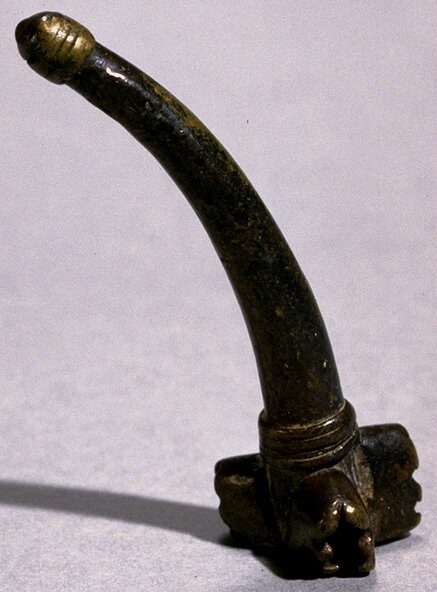Gold-weight
Akan

Description
Subject Matter:
Figurative gold-weight in the form of a side-blown elephant horn (akoben) with three human jaw bones (mmogye) around the wider end (cf. British Museum object number Af1948,21.92). One of the most common musical instrument depicted in gold-weights, these horns were created using ivory from the tusks of elephants. The use of these horns was associated with those victorious in war as well as chiefs, whose arrival was announced with musicians blowing these horns and beating drums. Phrases that copied the tonal language of Twi were played to praise the chief and his achievements, heard not only by the community but by ancestors and spirits as well. In this way, these musical instruments were used to communicate with the living and the dead, which rallied all members of the community around the chief on important occasions (cf. Sheales, African Goldweights, 2014). Important elephant horns used to be decorated with human jaw bones so that their empty oral cavities could resonate with the praises of the chief. (cf. Sheales, African Goldweights, 2014). The proverbs associated with these horns reflect their past use in war and their communicative properties: 'The war horn (akoben) means trouble is on the way' (cf. Sheales, African Goldweights, 2014); 'When an army is defeated a horn is not blown in its honour' (cf. MacLeod, The Asante, 1981, p. 110); 'The horn allows us to know the rank of the chief'; and 'If a horn deserves a jawbone they attach one to it' (cf. Garrard, Akan Weights and the Gold Trade, 1980, p. 209).
Physical Description:
Gold-weight in the shape of a curved rod with an incised knob at the narrow end and three notched arches at the wider end.
Usage Rights:
If you are interested in using an image for a publication, please visit https://umma.umich.edu/request-image/ for more information and to fill out the online Image Rights and Reproductions Request Form.